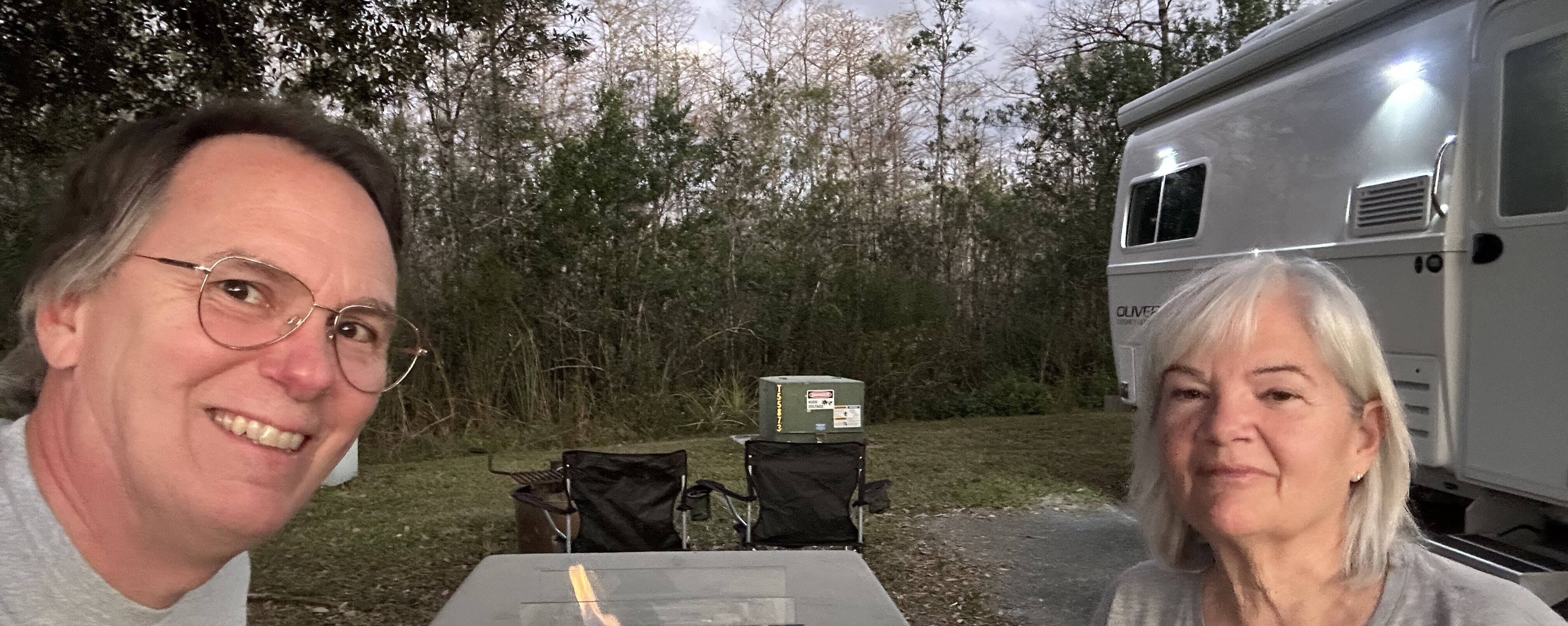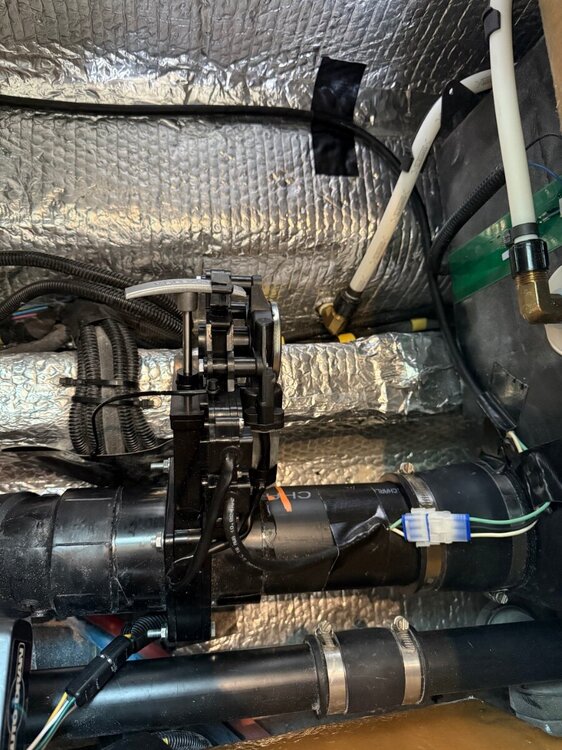
Galileo
Member+-
Posts
252 -
Joined
-
Last visited
-
Days Won
5
Everything posted by Galileo
-
Detail-Cleaning the MaxxFan Ventilator
Galileo replied to Galileo's topic in Mechanical & Technical Tips
The factory is pretty good at walking you through troubleshooting. (The fan mfg - not OTT). They gave me direction to troubleshoot my fan motor - and then sent me one gratis even though it was out of warranty. I -think- the control board should be a pretty easy R&R. Keyed connectors for both motors, pigtails for power. I imaginare that the circuit board and the membrane keypad are one piece - but don’t quote me. There’s also a temperature sensor. You can get up the circuit board by just removing the manual open/close knob (one screw) and the whole faceplate comes off with 4 more screws. Probably best to pull the bezel off as well so you can get to the power wires. Also 4 screws, but I found mine was helpfully (not) also glued on either white RTV and some butyl tape underneath. Just use a credit card to run around the perimeter to defeat the RTV. -
Detail-Cleaning the MaxxFan Ventilator
Galileo replied to Galileo's topic in Mechanical & Technical Tips
That’s fine for cleaning the fan blade & screen. Unfortunately, the rest of the fan collects just as much grime and dirt. Aside from @jd1923’s pressure washer trick, the rest of the unit needs cleaning just as much. -
Detail-Cleaning the MaxxFan Ventilator
Galileo replied to Galileo's topic in Mechanical & Technical Tips
I was with you 100% until this statement. Walked through an Ikea ONCE in Austin TX. Could not wait to get out of their maze of cheap kits, ASAP leaving EMPTY-HANDED! 🤣 My son who has been an Angie's List contractor, on and off, has installed these kits for the mechanically-impaired for big bucks! Hey - I generally don’t care for IKEA “furniture” either. (Though I used to have my share of “O’Sullivan” pressboard bookshelves and entertainment centers.) I just used IKEA as a reference gif people who are remotely familiar with common hand tools and putting together adult Lincoln Logs. -
Detail-Cleaning the MaxxFan Ventilator
Galileo replied to Galileo's topic in Mechanical & Technical Tips
I occasionally do some pretty daring things - including flying single engine aircraft and climbing on ladders. This ^^^ is something that increases my pucker factor to an unacceptable level. Then again, I might opt for this method if I was drinking hard with a buddy and he dared me. Even if I wasn’t worried about the circuit board (which I would definitely be!) how much dirty soapy water ended up -inside- the trailer would be a concern. Another concern would be damaging the hood with the power of a pressure washer. That said - if it’s working for you - who am I to say not to do it?! -
Detail-Cleaning the MaxxFan Ventilator
Galileo replied to Galileo's topic in Mechanical & Technical Tips
I kinda dove into it feeling confident that once I saw how it came apart, I’d be able to put it back together. Had I needed to drill out rivets or the like, I would have hesitated to take it further apart. It’s really not as complicated as it looks. I did feel the need to take it apart not only because it was disgusting inside, but because one of the operating arms looked like it was about to pop out of the slot in the hood. Next time (another three years or less I’m guessing) I’ll try to do a video or step-by-step photo essay. I’d say it’s in the comfort zone of anybody who has rebuilt a carburetor (remember those?) installed a ceiling fan, or shops regularly at IKEA. Aside from being a little dirty - it actually was kinda fun! Always nice to see something grimy and needing a bit of TLC look shiny and new again! -
Finally finished! I admit to being quite lazy and uninspired - and yes - busy traveling and not in one spot long enough to get to it. But, the rest of the Valterra electric black tank dump valve installation is complete! The 18-3 wiring harness that came with the valve was far too short. Since I was going with a longer run, I upgraded to 16-3. I used the existing manual valve cable to pull the electric cable through. It was certainly easier than if I had to pull a harness with terminals on both ends. Only snag (literally) was where the original cable was taped to the insulation. I had to duplicate the control end of the cable. Basically 5 crimp-on 1/4” female disconnects and two jumpers. The valve end of the harness has a special connector which I couldn’t find the terminals or removal tool for - do I just butt-spliced it onto the end of my harness. Not my preference, but it was either that or cut out the connectors entirely and just butt-splice the harness right onto the valve. Six of one, half a dozen of the other. First picture shows where I installed the control. I contemplated putting it where the manual pull handle was - but it’s a tight fit, and I’d have to scrap the switch plate and open/closed legend. That, and it looked much easier to make the cutout in the place I put it than the manual dump handle location. I’m not super thrilled with this location - and having visions of it being actuated by accident - by an elbow or something I toss back there. (I don't wanna go full Dave Matthews on anybody!) I debated adding another switch, but for now, I can always swing the valve handle out of engagement with the actuator until I’m ready to dump. The “board” here - between the basement area and the location of the outdoor shower and other goodies is easily cut with a spade bit and a utility knife. Second picture shows the valve in position. Pretty straightforward. The electric physical valve swaps out with the manual one. Route your wires, use OTT official black gorilla tape to hold cable in place. Snap the connectors together and - Bob’s your uncle.
-
Andersen WD Hitch Periodic Maintenance?
Galileo replied to Galileo's topic in Mechanical & Technical Tips
Is that raise the TV up 2” from its normal, un-hitched ride height, or up 2” after lowering the trailer into the hitch with no tension on the chains? Either way sounds like it will give you minimal WD from the chains. I guess it depends upon how stiff your suspension is. Our previous TV seemed to have a stiffer suspension, and it would depress less than our new TV seems to. So I find myself going tighter on the chains than I did previously to maintain a level TV. As touchy-feely as they are, I try to follow the Andersen instructions as written (both from their site and as reprinted in the OTT manual) and I seem to get the indications right. We switched to a “higher” truck around the first of the year, so the hood pretty much always seems “high” these days - and this seems to be the lowest-slung Sierra GMC builds unless you do some aftermarket stuff to lower it. This truck (supposedly) also has some “active suspension”, but I don’t know what real effect that has or if it’s even active when a trailer is attached. (And it -knows- when a trailer is attached!) -
Gorilla compact 25’ hose for marine and RV use
Galileo replied to Patriot's topic in Mechanical & Technical Tips
I’ve been down the route with the quick connects before. Generally I like them. I had a bunch of “Gardena” (high-end German made) ones when I did a lot of outdoor stuff. I’d have to find one I thought was really great before I invest in as many as I’d like. I do find that they’d tend to leak after a while. Some you could get replacement O-rings for. For now, I’ll stick with the GHT and spend an extra minute hooking/unhooking. I do the same thing - but without the flow meter. Once I have the black valve open I unleash the Sann-T-Flush water and close an open the valve a couple of times. I just “guess” when I’ve got a couple of gallons into the tank. -
Andersen WD Hitch Periodic Maintenance?
Galileo replied to Galileo's topic in Mechanical & Technical Tips
Seems odd that after three years, my friction material was toast (literally) and yours showed little wear after ten. Perhaps I’m cranking on the chains too much? The instructions are kinda vague - elastomers should show a “bulge” - which, being strictly visual, is subjective. I generally find that trying to get as many threads showing as they suggest after the hand tightening of the nuts seems like it takes quite a bit of force. But, to do any meaningful “weight distribution” it would seem like a high amount of force -would- be required. The only time I’ve heard any noise or seen any significant wear on the (old) ball is if I don’t make the chains tight -enough- allowing some play in the system. The experiment continues! -
Gorilla compact 25’ hose for marine and RV use
Galileo replied to Patriot's topic in Mechanical & Technical Tips
After getting disgusted with the white Camco hoses (stiff, bulky, kinks easily, can’t take prolonged pressure) I snagged a Zero-G hose on impulse at Camping World. (One of the very few things I didn’t buy from Amazon.) It’s lightweight, flexible, and very flexible even when cold. I have two minor gripes: the connectors seem to be zinc or some alloy that corrodes. Not to the point of crumbling, but it does make it hard to thread. I’ll try a little plumbers grease and see if that helps. Also, as the hose material is quite soft, you could probably twist or damage it if you’re not careful about tightening/loosening it. It could use an extended “grip” just behind the coupler. I have a dedicated Zero-G hose for city water or fresh water fill, two old Camco hoses for added length if needed, and a cheapo green hardware store hose for black tank flushing or grey water drain. Though storage IS at a premium on the LE2, the above hoses, electric cable, water pressure regulator, and a few other things fit easily in the “basement” accessible from outside. -
Andersen WD Hitch Periodic Maintenance?
Galileo replied to Galileo's topic in Mechanical & Technical Tips
Seems like an unlikely part to be covered under warranty - unless it fails prematurely. Surely it’s a “consumable” part - like a brake lining. At any rate, I didn’t know it would have been covered under warranty and wouldn’t expect it to be, so I bought one soon after we purchased the trailer to keep as a spare. For that matter, I also bought two of the elastomer bushings, extra tensioning nuts Acme threads) and washers since I figured these are all parts that will wear (a lot of force, friction, and dirt). That said, my original ones are still there and looking much better than I’d expect. Then again, I’ve used “NeverSeize” on the threads and thrust surfaces of the washers and nuts since early on. It really reduces the torque need to load the WD system. It also hasn’t seemed to make the nuts loosen or back off. (Blushing: I also bought spare chains with the treaded studs as I figured they would wear as the nuts would….) Anyway, I found very little service or maintenance information available in either the Andersen hitch instructions or online. So I did the “belt and suspenders” approach to having spares in hand. -
Andersen WD Hitch Periodic Maintenance?
Galileo replied to Galileo's topic in Mechanical & Technical Tips
I’ve ordered two friction cones directly from Andersen. The latest ones supplied are red, but they’ve shipped me a light blue one previously. They’ve changed the material at least once. Why? Dunno. -
TLDR - this post tells you in words how to detail-clean your MaxxFan I haven’t seen it posted anywhere else so far, so I thought I’d throw this out there. After three seasons of practically full-time use of our Ollie, the MaxxFan was looking pretty cruddy - especially when it was sunny and you could see the dirt and grime buildup inside the hood. The fan “maintenance” I’ve found online seems to be limited to cleaning the screen and maybe the fan blade. I had done that a few times, but it didn’t address the real dirt. There’s no way to clean inside of the hood with the unit assembled. Nor would you want to try doing that with the unit overhead. Since I had to pull the unit off the roof to replace the motor. (Wouldn’t go above 30% without beeping, and shutting down.) I decide to pull the whole unit apart and give it a serious bath. Sorry for no pictures - by the time I thought of that I was elbow-deep into soapy water. Instead, I’m giving you the 10,000 words. I pulled the control panel with circuit board, the fan motor, and the open/close gearbox off the unit. I left the rest of the opening mechanism in place. I pretty much tore the unit down to individual parts. Every screw - aside from those holding the open/close mechanism to the main frame - was removed. Start with the hood in “open” position. It’s probably easiest to remove the interior bezel and manual open/close knob first - though it may be possible to access the power wiring with it in place. The black ground wire and white + wire can be disconnected by removing the electrical tape Oliver put over the connectors, and lifting the orange tab to release the wire. (I was originally thinking I’d have to cut & re-splice the wires, believing Oliver used some kind of crimp-on connector. In my case, luckily not.) Once on the roof, removing two screws on each side of the base on the unit will allow it to lift the unit off of the roof. Back on terra firma- Flip the unit on its back - upside down - on your workbench. (Picnic table?) If you didn’t remove the control panel and circuit board, do so now and set it aside. (Four screws for the control panel, one more in the center of the open/close knob.) The fan motor and open/close gear motor have keyed 2-wire connectors that attach them to the circuit board pigtails. The hood is held on by eight sheet metal screws that go into “u” nuts, so no worries about screws going into plastic stripping out. Five at the front edge, three at the rear edge. Once those are out, disengage the hood operating arms and lifting the rest of the unit off/out of the hood. Be sure not to lose the two plastic bushings that fit over the pins in the ends of the operating arms. The pivoting rear grille has two keyed tabs that attach it to the main frame. Rotate the grill up to disengage them. That frees the grille. At first, I left the piece of hardware cloth and its plastic retainer attached to the grille. Later, I found I couldn’t clean it thoroughly with it assembled, so I took out the four screws. These four DO go into plastic, so use proper technique when reinstalling them. The fan motor wiring is held in place with a plastic clamp and two screws. Take out the screws, lift off the clamp and feed the motor wire connector out through the hole. The motor is held in with two nuts onto threaded through-bolts. I think they were 5/16”, but don’t quote me. There are also a couple of wire ties holding the motor wires to the support “spoke”. These can be clipped off. You’ll need new ones. I used electrical tape. The open/close gear motor is held on by three sheet metal screws. Be sure to remove the ones holding it to the frame - not the ones holding the gear motor together. There also a splined coupling between the gear motor shaft and the opening mechanism. This is loose, so make sure you don’t lose it. Now - all the electrical parts are removed, you can do the cleaning. I sprayed all the dirty surfaces with a household cleaner/degreaser. “Fantastic”, “409”, etc. I used Clorox kitchen cleaner because that’s what I had available. I suppose you could use Dawn or TSP or whatever your favorite water-based cleaner degreaser is. I used a cheapo hardware store “chip brush” to do the cleaning. There are a LOT of crevices and internal corners to collect grime. I probably took about 30-45 minutes with the brush, then sprayed the parts off with a hose. You’ll probably see spots you missed to revisit with the brush and the 409. Dry everything off and admire your handiwork! As the old saying goes: reassemble in reverse order. Really. One caution: to avoid stripping out thread-cutting screws that go into plastic, set the screw in place and with just the weight of the screwdriver on the screw, turn it slowly -backwards- until you feel it “drop in” to the old thread. Then gently turn clockwise to tighten. It -should- screw in fairly easily until it’s fully seated. All of the above just goes to say that if your MaxxFan starts to look like the inside of your range hood (and it will if you use it much - especially if you cook inside of your camper) then you can easily clean it to like-new condition with just some time and effort.
-
Unfortunately, it does not fold up enough to store compactly. OTOH - it is light. My last searches (Amazon, eBay) showed solar ovens/cookers that are a lot flimsier than the Sun Oven. They literally look like they would blow away with a slight breeze, and they appear to have little or no insulation. To be fair, the SunOven does take up a chunk of space in my pickup bed - but I keep all the graniteware pots inside if it, so it’s not just wasted space.
-
Andersen WD Hitch Periodic Maintenance?
Galileo replied to Galileo's topic in Mechanical & Technical Tips
I had to replace the ball/shaft and the body. I waited too long and the friction material wore enough that there was some metal-to-metal contact that galled the aluminum body. The friction material was worn completely through at the lower, aft end of the ball shaft. I was able to smooth it out a bit, but felt more comfortable replacing both metal parts along with the friction material. Probably why I was asking about “preventative maintenance”. Apparently three years exceeds the service life of the friction material. It would be nice if the Andersen folks were a little more forthcoming about service lives, actual PM schedules, and other specifics. I guess I have nothing to complain about. We’re pretty much “full-timers” 8-9 months of the year and put almost 80,000 miles on the TV over those three years. I purchased (another) friction cone and snap ring and I’ll just make it a practice to check/replace it every season. Perhaps rotating it 180 degrees if it looks good. Again - I’m pretty OCD about parts that create ugly scenes should they fail. I had actually considered replacing the Bulldog couple and the hitch ball every couple of seasons just to be as safe as possible. (Pilot mentality) I don’t want to test that old rule of thumb about crossed safety chains “catching” the trailer tongue should a hitch component fail. I also had to dig out my old BIG snap ring pliers as the cheapo Ace hardware ones don’t have the oomph to get the big snap ring off and on. It’s been added to my “trailering” bin. -
Epoc Lithium "Keep-It-Simple" Upgrade Advice
Galileo replied to tallmandan's topic in Ollie Modifications
Very slick! With Apps - you don’t have to cut new holes! Only one I’m using so far is the LevelMate Pro+ - but it’s a huge timesaver while setting up! -
Is that an Oliver-approved modification? Frame/chassis designed (warranted) to carry that increased load? I saw a recall come out a while ago that some LEIIs left the factory with 5,600# Bulldog couplers. (Ours is the correct 7,000# one) I’m assuming the folks who have upgraded their springs and brakes have also upgraded their couplers?
-
Sure, I could tank up and carry the 632 # ((32+32+15)*8) but that’s 632# less gold bars, guns, and ammo I can carry! (Just trying to avoid tankering around something that I’m unlikely to need. Pilot training) Sure - I -could- get stranded someplace and -wish- I had full water tanks and empty waste tanks, but I could also get a flat tire and have to jack up that much more weight. Anyway, you have to get that additional weight up to speed (fuel efficiency) and stop it (brake wear) so I try to keep everything as light as possible. I even TRY to get my wife to take along 20-30# less in mousse, moisturizer, and various creams and lotions… After all, MUST make sure we reserve some of that useable load for several bottles of wine, Basil Hayden Rye, vermouth, and Luxardo cherries… (Priorities!)
-
Dunno why the mfrs of RV air conditioners haven’t included the features that even cheapo window units have. Though sometimes I like a fan running all the time just for circulation sake, most of the time I want the fan to shut off. That said, I want the fan to run until the evaporator coils have equalized in temperature before the fan shuts down. I forget what they called that setting on my last window units, but it was nice. If/when the fan and compressor shut down at the same time, you have all that nice cold just wasted there in the housing. May as well blow it out into the area you’re trying to cool, right? I think a lot of folks buy too many BTUs and it’s counterproductive from what I’ve read. If you cool the room (trailer) too quickly, you don’t move enough if the room air across the evaporator coils to adequately dehumidify the air. That’s (more than) half the battle in making interiors comfortable when it’s hot and humid. As I understand it, there’s a new generation of high efficiency a/c’s that use another method of reducing humidity.
-
This looks pretty slick. Surprised they picked a V6 to run the generator. I guess they figured they needed it. Neat thing that will put a technology like this at a pretty decent advantage is the regenerative braking. That’s even more significant while towing as you have a LOT more inertia to turn back into energy. That’s something even the most efficient ICE powered vehicle can do. Going up a long incline just means you are never getting that energy back in a conventional vehicle. In an EV, you can smile as you regenerate all the way down the hill. The smallish battery may actually limit how much you can store. I had that issue with the Prius. Still - I’ll take a look at it later this year!
-
I’d like to see the numbers behind that “1%” you quote. Sure, a little Honda generator may only 1/100th of the horsepower of a Tesla - but a Tesla (or any ICE) powered vehicle isn’t putting out its full rated HP at cruise. Likely not even at acceleration to cruise unless you’re really mashing the snot out of it. It may only be putting out 40HP - and that’s a generous guess. Im not debating the laws of conservation of energy. I’ll even concede that in this conversion from one form of energy to another, there are efficiency losses. That said, fossil fuel is a good way to store energy - probably why we keep filling our tanks with it. I can’t speak to the Tesla, but EVs typically are pretty good with rolling resistance, aerodynamics, and minimizing the amount of power required to keep them rolling once gotten up to speed. That’s why driving technique (in any vehicle) can impact the mileage you get by a significant factor.
-
I used to be a “tech” guy back when Oracle 7 and Windows 7 were state of the art. Listening to you guys banter back and forth is making me feel like the caveman in those insurance commercials…. 😥 Guess I’ll just take my Orbic hotspot and slink off into a corner….
-
Epoc Lithium "Keep-It-Simple" Upgrade Advice
Galileo replied to tallmandan's topic in Ollie Modifications
I’ll be watching this thread as well. We have whatever the “default” batteries were being supplied in 2022 (“BriteStar” I think is the name) as well as whatever they were supplying as a charger. No solar here - though may do a “suitcase” down the road. -
No, sloshing “water” around in the black tank is probably a good thing. But as I mentioned, we rarely put anything that needs sloshing in our black tank. Just how we roll. I try to baby our systems as much as possible. Aside from not caring to tote around water to get stale and start growing things, my major reason is the 600 plus pounds you’re starting, stopping, and supporting with your RV and TV suspension. The Oliver is heavy enough without having water taking up half the carrying capacity of the trailer. Yeah, I -suppose- if we got to a campground that was supposed to have potable water, but didn’t, we’d be unable to flush the toilet or wash dishes, but we always have drinking water. That, and I keep a lightweight, collapsible 5 gallon water “jug” handy. I was only tempted to use it once. Opted instead for a l-o-n-g potable water hose to squirt a few gallons into the FWT. IF we have full hookups, I dump before leaving the site - because I like the nose of the trailer as high as possible to get good drainage. But we never use the site sewer “real-time”. If no sewer connection, we hit the dump station before hitting the road. (That’s the way turkey vultures do it - vomit before departure to reduce takeoff weight!)
-
Eh, this thread was still active just 5 months ago, so maybe it’s not dead yet. When selecting our new TV, we did consider an EV for about a microsecond. That was before we knew the range was SO much less while towing. Anyway, previous to the Ollie and towing - aside from an hauling occasional farm trailer a few miles with a 2000 Ford Ranger (with 340,000 on the clock) our daily driver was a 2017 Prius. I really liked that car. The rural mileage was phenomenal - 60 mpg - and even highway (not a hybrid’s forte) was almost 50 mpg. The tech in an eight year old car was better than in my 2025 GMC. I always thought the typical hybrid drive system is overly complicated - driving the wheels with the ICE and/or electric. But was also very impressed with how simple the electronic CVT is. No clutches in there like a conventional ICE trans. The motor/generator working with/against the ICE provides all the ratios needed. That said, I think a much more efficient “hybrid” system would be one like the diesel/electric locomotives use. One where the diesel engines run at a constant (efficient) speed and serves solely to spin generators. That would leave the drivetrain very simple as it is in a full EV. I would think a dedicated shade tree mechanic with just enough knowledge to make him dangerous could concoct something like this with an F150 lightening, Rivian, or (yuck) a Cyberttuck. Slap a Honda 2200EUi or two in the bed and see what kind of mileage increase can be obtained. Generators could be charging the HV battery at stop lights, and -may- even be able to supply all the power needed at cruise when power demands of accelerating to cruising speed drops off. The battery is still there to do the heavy lifting (hailing) of getting the truck and trailer up to cruising speed.






